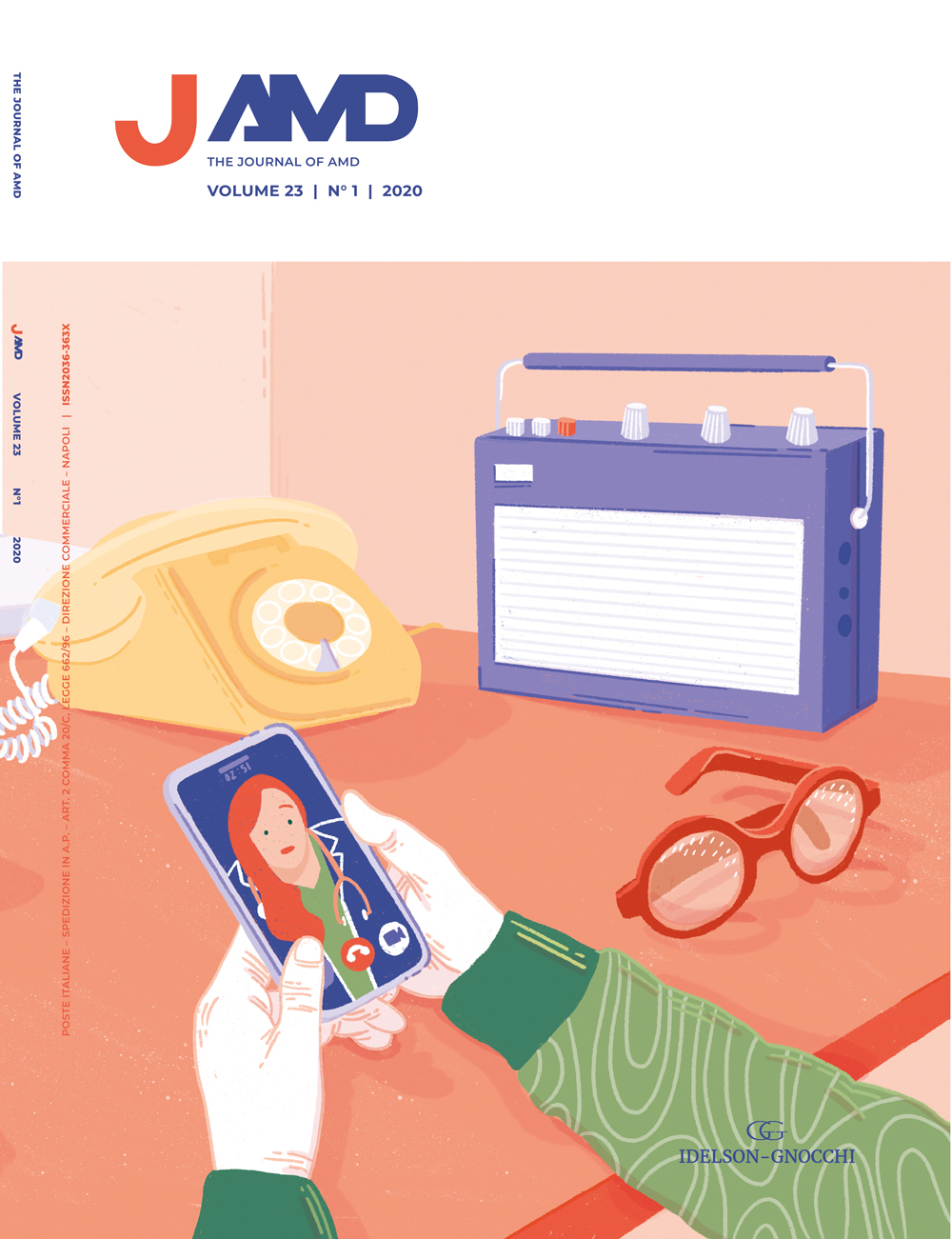Emergenza COVID-19
Clinical guidance for the prevention and management of COVID-19 in people with diabete
JAMD 2020;23(1):7-9
So that fear doesn’t turn into panic
JAMD 2020;23(1):17-18
Research article
The SELFIE 2.0 project (SELF assessment for the therapeutic appropriateness in people with diabetes): proposals to improvethe approach to therapeutic intensification in patients with type 2 diabetes with inadequate metabolic control
JAMD 2020;23(1):19-27
The SELFIE project (SELF assessment for therapeutic appropriateness in people with diabetes) was designed to collect the perceptions and opinions of 60 diabetologists in 12 territorial meetings. The objective was to launch the debate between experts through a structured discussion procedure to identify the main “barriers to intensification” of diabetes treatment (first phase) and the “possible solutions” (second phase). The discussion took into account that DPP4-inhibitors prescription still requires a “therapeutic schedule” in Italy. So, the specific barriers of 8 different profiles (phenotypes) of patients with inadequate metabolic control, classified in terms of age, renal function and treatment with one or more glucose-lowering drugs were highlighted.
This article summarizes the results of the second phase. Optimizing / simplifying drug therapy, establishing a therapeutic alliance with the patient, involving a caregiver to act on motivation / communication with the patient, improving organizational aspects, reducing bureaucracy and stimulating the doctor’s attitude to change are the key points that emerged as crucial for overcoming clinical inertia. Implementation of these solutions based on their applicability to the different phenotypes was debated though standardized discussion procedures.
Implementing these solutions, monitoring their adoption and measuring the results obtained in the short- and long term, simultaneously focusing on the training of patients and healthcare professionals, is a challenge for the entire diabetes community, to improve the care provided and the clinical outcomes.
KEYWORDS type 2 diabetes; glycemic targets; therapeutic inertia; DPP-IV inhibitors; professional education.
Real world evidence on the management of patient with type 2 diabetes. Results from a blended CME experience
JAMD 2020;23(1):28-36
OBJECTIVES In Italy, approximately over 35% of people diagnosed with T2DM are aged between 65-75, while 26% of the patients is between 75 and 85 years old. Elderly diabetes management represents a challenge for doctors, because of the co-existence of multiple comorbidities and a frailty state which increase the risks and consequences of hypoglycaemia. Many drugs with different cardio-renal mechanism of action and safety profile are available to treat diabetes which requires continuously complex decision making. The educational project “Real world evidence nella gestione del paziente con T2DM” has been designed to understand the management approach for patients with T2DM and to allow the evaluation of different therapeutic strategies.
METHODS The educational project was divided in three modules: the first and the last trought webinar; the second held in daily practice – the participants have to register structured observation. The project has been joined by 55 discussants and 7 tutors. The 2,201 observations collected allowed the understanding of epidemiological aspects, which included information relating to monitoring of blood chemistry parameters and of therapeutic approaches.
RESULTS The therapeutic approach has been confirmed in 28% of the observations; 72% of the observations have shown treatment change because of metabolic syndrome or because of a number of hypoglycaemia episodes.
CONCLUSIONS The educational project proved to be an effective instrument to improve the management of patients diagnosed with T2DM in real life.
KEYWORDS type II diabetes mellitus; DPP4 inhibitor; elderly patient; metabolic compensation; renal impairment.
Real Time Continuous Glucose Monitoring, Flash Glucose Monitoring and implantable glycemic sensors: features and peculiarities
JAMD 2020;23(1):37-48
Nowadays self monitoring blood glucose (SMBG) in type 1 diabetic patients frequently gives way to real time continuous glucose monitoring (rt-CGM) or “spot” checking of glucose “Flash Glucose Monitoring” (FGM) without the need for finger stick controls. These sensors offer unknown functionality to SMBG systems by giving a real time visualization of the glucose data, with arrows informing the user of rising or falling blood glucose and also the speed of this glycaemic variation from moment to moment and with the possibility to receive alarms and alerts when pre-established glycemic levels (both high and low) are reached or are about to be reached (predictive alarms). This not only significantly improves blood glucose control with a reduction in hypoglycaemic events but also offers doctors an incredibly complete set of blood glucose data, organized in easily consultable graph and table formats. However CGM systems are not all the same and for good resource management the choice of CGM/FGM should be “tailor made” to fit the individual characteristics of each patient. For this reason we have compared the best CGM/FGM devices currently available in an attempt to offer advice (and considerations) for those prescribing such devices and how to make a prescription “best-fit” for patient.
KEYWORDS self monitoring blood glucose (SMBG); continuous glucose monitoring (CGM); flash glucose monitoring (FGM).
Off-label prescription of SGLT‑2 inhibitors to patients with type 1 diabetes: an online survey of diabetes specialists and safety recommendations
JAMD 2020;23(1):49-60
AIM OF THE STUDY Sodium-glucose cotransport inhibitors (SGLT-i) improve glycemic control in patients with type 1 diabetes (T1DM). However, their use is associated with an increased risk of diabetic ketoacidosis (DKA). Aim of this study was to evaluate the off-label prescription of these drugs to patients with T1DM.
MATERIALS AND METHODS From 2018/08/21 to 2019/04/03 AMD invited members to complete a survey on the off-label prescription of SGLT2 inhibitors (SGLT2i) to patients with T1DM.
RESULTS N = 161 specialists completed the survey; 72 (44.7%) had prescribed SGLT2i for T1DM patients. Prescribing and non-prescribing specialists were similar for years in practice and type of outpatient facility. Specialists from Northern Italy or caring for ≥50 T1DM patients were more likely to prescribe SGLT2i to their patients. Specialists prescribed SGLT2i mainly to T1DM patients on multiple daily insulin injection. The most frequent reasons for SGLT2i prescription were to improve suboptimal glycemic control, facilitate weight loss and reduce insulin requirement. Only 48% of specialists required patients to sign an informed consent for the off-label prescription.Twenty-five percent of specialists omitted to prescribe strips for ketonuria/ketonemia and only 26% recommended to measure ketones when glucose levels exceeded 200 mg/dl. All specialists recommended avoiding dehydration and prolonged fasting when using SGLT2i, but only 23% reviewed the symptoms of ketosis and only 9.7% offered patients the six expert recommendations for mitigating the risk of DKA. Nearly 20% of specialists who prescribed SGLT2i to T1DM women of childbearing age omitted to inform them of the risks for conception, and only 12.5% provided patients with the four recommendations that should be given when prescribing drugs not authorized in pregnancy.
CONCLUSIONS The results of this survey document the need to improve the awareness of professionals and patients about the risks of DKA and risk mitigation when SGLT2i are prescribed to T1DM patients.
KEYWORDS SGLT inhibitors; type 1 diabetes; diabetic ketosis/ketoacidosis; off-label prescription.
Reviews
The role of metformin in the light of the most recent Guidelines
JAMD 2020;23(1):61-66
Metformin was introduced in the market about 60 years ago and is definitely the most used drug in people with type 2 diabetes mellitus at the moment. In fact, it has insulin-sensitizing properties, through which it provides not only doubtless glucose lowering effects but also some protection against ADRD and cancer and especially significant cardiovascular benefits. We hereby briefly review the literature behind the above mentioned extra-glycemic effects and, based on expected additional benefits, suggest to refrain from delaying metformin utilization in addition to first class drugs like inhibitors of type 2 sodiumglucose cotransport (SGLT-2i) and /or glucagon-like peptide 1 receptor agonists (GLP1-RA) in people at high cardiovascular risk with newly diagnosed type 2 diabetes.
KEYWORDS metformin; diabetes mellitus; cardiovascular disease; ADRD; cancer.
Punto di vista
Diabetes treatment today: an exciting confusion
JAMD 2020;23(1):67-69
Indications for the use of continuous or flash glucose monitoring systems in T2DM patients
JAMD 2020;23(1):70-72
Indications for the use of continuous glucose monitoring systems in DMT1 patients and for the pregnancy of diabetic women
JAMD 2020;23(1):73-74
Attività dei gruppi di studio
Real World Evidence: welcome to reality!
JAMD 2020;23(1):75-78
Real World Data (RWD) constitute a set of information sources on which the very current line of research of Real World Evidence (RWE) is based. RWE studies are based on data from observational studies, administrative databases, population or disease registers, insurance registers, electronic medical records, population health surveys and, more recently, social media and data from mobile devices and apps. While Randomized Clinical Trials (RCTs) answer the question “Can it work?” “Is it safe?” RWDs are more interested in answering the question “Does it work?”. We therefore move from a question of “efficacy / safety” to one of “effectiveness”. RWE studies allow to evaluate the safety of a treatment in a longer period than that of the RCTs, verify its quality and cost effectiveness, allow us to trace the natural history of a disease conditioned or not by a treatment, give us relevant information on compliance and on adherence to treatments and allow us to identify service models and patient preferences. Given the exciting perspective that the “real” vision of things outlines, AMD has decided to keep up with the times by forming a Group of work on “Real World Evidence”. The activities that the RWE Working Group is already promoting and carrying out are: 1) support for the publication of clinical cases; 2) support for the drafting of research protocols; 3) analysis of the Annals database. Addressing Real World Evidence in the widest possible way by collaborating with interested AMD Members, aligning with the need to give a concrete face to things, represents the vision of this Group. “Welcome to reality”!
KEYWORDS Real World Data, Real World Evidence, effectiveness.
22° congresso AMD – Sessione congiunta AMD-ADA
Therapeutic inertia and its impact on treatment and diabetes outcomes: the ADA approach
JAMD 2020;23(1):80-92
Le news di AMD
AMD Annals Newsletter n. 28
JAMD 2020;23(1):93-94
22° congresso AMD – Sessione congiunta AMD-ADA
Drivers and enablers of therapeutic inertia: is there a hierarchy?
Driver e fattori abilitanti dell’inerzia terapeutica: esiste una gerarchia?
JAMD 2020;23(1):83-85
Therapeutic inertia: how can we measure it? The AMD Annals experience
Inerzia terapeutica: come possiamo misurarla? L’esperienza degli Annali AMD
JAMD 2020;23(1):86-89
Therapeutic inertia in type 2 diabetes: getting from where we are to where we want to be
Inerzia terapeutica nel diabete di tipo 2: arrivare da dove siamo a dove vogliamo essere
JAMD 2020;23(1):89-92
Review article
Importanza di sesso e genere nel diabete: si soffia ancora nel vento
Relevance of sex and gender in diabetes: still blowing in the wind
JAMD 2020;23(1):95-96
Emergenza COVID-19
AMD-SID-SIE – Percorso visite ambulatoriali di controllo nei centri di Diabetologia (che già seguono la persona con diabete)
JAMD 2020;23(1):10-16




